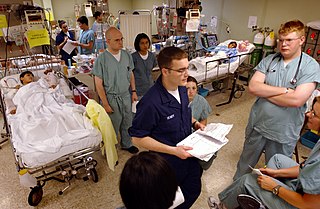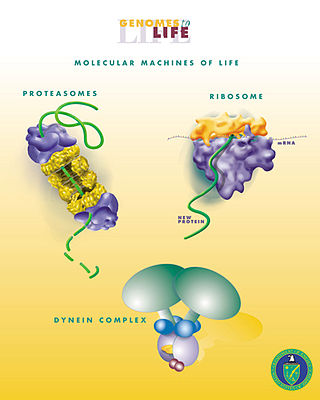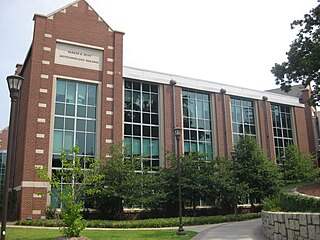Related Research Articles

Biomedical engineering (BME) or medical engineering is the application of engineering principles and design concepts to medicine and biology for healthcare purposes. BME is also traditionally logical sciences to advance health care treatment, including diagnosis, monitoring, and therapy. Also included under the scope of a biomedical engineer is the management of current medical equipment in hospitals while adhering to relevant industry standards. This involves procurement, routine testing, preventive maintenance, and making equipment recommendations, a role also known as a Biomedical Equipment Technician (BMET) or as clinical engineering.
A biomedical engineering/equipment technician/technologist or biomedical engineering/equipment specialist is typically an electro-mechanical technician or technologist who ensures that medical equipment is well-maintained, properly configured, and safely functional. In healthcare environments, BMETs often work with or officiate as a biomedical and/or clinical engineer, since the career field has no legal distinction between engineers and engineering technicians/technologists.

Clinical engineering is a specialty within biomedical engineering responsible for using medical technology to optimize healthcare delivery.
The School of Engineering and Applied Science (SEAS) at the George Washington University in Washington, D.C. is a technical school which specializes in engineering, technology, communications, and transportation. The school is located on the main campus of the George Washington University and offers both undergraduate and graduate programs.

Biological engineering or bioengineering is the application of principles of biology and the tools of engineering to create usable, tangible, economically viable products. Biological engineering employs knowledge and expertise from a number of pure and applied sciences, such as mass and heat transfer, kinetics, biocatalysts, biomechanics, bioinformatics, separation and purification processes, bioreactor design, surface science, fluid mechanics, thermodynamics, and polymer science. It is used in the design of medical devices, diagnostic equipment, biocompatible materials, renewable energy, ecological engineering, agricultural engineering, process engineering and catalysis, and other areas that improve the living standards of societies.

The Agency for Science, Technology and Research (A*STAR) is a statutory board under the Ministry of Trade and Industry of Singapore.
The College of Engineering at the Georgia Institute of Technology provides formal education and research in more than 10 fields of engineering, including aerospace, chemical, civil engineering, electrical engineering, industrial, mechanical, materials engineering, biomedical, and biomolecular engineering, plus polymer, textile, and fiber engineering. The College of Engineering is the oldest and largest college of the institution.

The National Institute of Biomedical Imaging and Bioengineering (NIBIB), founded at the National Institutes of Health (NIH) in 2000, is located in Bethesda, Maryland. It is one of 27 institutes and centers that are part of NIH, an agency of the U.S. Department of Health and Human Services (HHS).

The Wallace H. Coulter Department of Biomedical Engineering is a department in the Emory University School of Medicine, Georgia Institute of Technology's College of Engineering, and Peking University College of Engineering dedicated to the study of and research in biomedical engineering, and is named after the pioneering engineer and Georgia Tech alumnus Wallace H. Coulter. The graduate program has consistently ranked 2nd in USNWR rankings, while the undergraduate program ranks 1st in USNWR rankings.

The Springfield High School of Science and Technology (HSST) is a public high school located in Springfield, Massachusetts, United States. The high school is home to grades 9–12. As of September 2008, the student count was approximately 1,700 students. This makes Science and Technology the third largest high school in Springfield, behind Springfield Central High School and the High School of Commerce. It is located directly next to Springfield's Roger L Putnam Vocational-Technical High School and the two schools share school buses.

Gordana Vunjak-NovakovicFRSC is a Serbian American biomedical engineer and university professor. She is a University Professor at Columbia University, as well as the Mikati Foundation Professor of Biomedical Engineering and Medical Sciences. She also heads the laboratory for Stem Cells and Tissue Engineering at Columbia University. She is part of the faculty at the Irving Comprehensive Cancer Center and the Center for Human Development, both found at Columbia University. She is also an honorary professor at the Faculty of Technology and Metallurgy at the University of Belgrade, an honorary professor at the University of Novi Sad, and an adjunct professor at the Department of Biomedical Engineering at Tufts University.

Sahrdaya College of Engineering is an Engineering college situated in Kodakara, Thrissur District which offers Bachelors, Masters and Doctoral programmes in Engineering and Technology. Sahrdaya is the "only Engineering College in Kerala, consistently with above 80% pass" in the result analysis of engineering colleges at Kerala by the Department of Technical Education and University of Calicut under the direction of Hon High Court of Kerala in 2012. The college is run by Syro-Malabar Catholic Diocese of Irinjalakuda. The college is affiliated to All India Council for Technical Education (AICTE) New Delhi, and the APJ Abdul Kalam Technological University.

Biomedical sciences are a set of sciences applying portions of natural science or formal science, or both, to develop knowledge, interventions, or technology that are of use in healthcare or public health. Such disciplines as medical microbiology, clinical virology, clinical epidemiology, genetic epidemiology, and biomedical engineering are medical sciences. In explaining physiological mechanisms operating in pathological processes, however, pathophysiology can be regarded as basic science.
The IEEE Biomedical Engineering Award is a Technical Field Award of the IEEE given annually for outstanding contributions to the field of biomedical engineering. It was established in 2010.
Project Lead The Way (PLTW) is an American nonprofit organization that develops STEM curriculum for use by US elementary, middle, and high schools.

Molly Morag Stevens is Professor of Biomedical Materials and regenerative medicine and Research Director for Biomedical Materials Sciences in the Institute of Biomedical Engineering at Imperial College London.

The Malawi University of Science and Technology (MUST) is a public university in Thyolo in South Malawi. It was established on 17 December 2012. MUST opened doors in March 2014, the first undergraduate programmes were: 1. Metallurgy and Materials Engineering 2. Chemical Engineering 3. Biomedical Engineering
Irene Rena Bizios is an American bioengineer. She is the Peter Flawn Professor at University of Texas at San Antonio and the Lutcher Brown Chair Professor in the Department of Biomedical Engineering. Bizios is an Elected Fellow of the National Academy of Medicine, National Academy of Inventors, American Academy of Arts and Sciences, National Academy of Engineering, and American Institute of Chemical Engineers. Her current interests are cellular and tissue engineering, biocompability and tissue-biomaterial relationships.
Science Publishing Group (SPG) is an open-access publisher of academic journals and books established in 2012. It has an address in New York City but is actually based in Pakistan. The company has been criticized for predatory publishing practices. As of 2019, it publishes 430 journals in various fields.
Biofabrication is a branch of biotechnology specialising in the research and development of biologically engineered processes for the automated production of biologically functional products through bioprinting or bioassembly and subsequent tissue maturation processes; as well as techniques such as directed assembly, which employs localised external stimuli guide the fabrification process; enzymatic assembly, which utilises selective biocatalysts to build macromolecular structures; and self-assembly, in which the biological material guides its own assembly according to its internal information. These processes may facilitate fabrication at the micro- and nanoscales. Biofabricated products are constructed and structurally organised with a range of biological materials including bioactive molecules, biomaterials, living cells, cell aggregates such as micro-tissues and micro-organs on chips, and hybrid cell-material constructs.
References
- ↑ "What Is Biomedical Technology?" . Retrieved 2018-10-02.